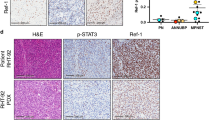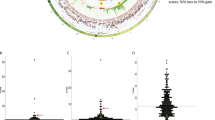Abstract
Malignant peripheral nerve sheath tumors (MPNSTs) are devastating sarcomas for which no effective medical therapies are available. Over 50% of MPSNTs are associated with mutations in NF1 tumor suppressor gene, resulting in activation of Ras and its effectors, including the Raf/Mek/Erk and PI3K/Akt/mTORC1 signaling cascades, and also the WNT/β-catenin pathway. As Group I p21-activated kinases (Group I Paks, PAK1/2/3) have been shown to modulate Ras-driven oncogenesis, we asked if these enzymes might regulate signaling in MPNSTs. In this study we found a strong positive correlation between the activity of PAK1/2/3 and the stage of human MPNSTs. We determined that reducing Group I Pak activity diminished MPNST cell proliferation and motility, and that these effects were not accompanied by significant blockade of the Raf/Mek/Erk pathway, but rather by reductions in Akt and β-catenin activity. Using the small molecule PAK1/2/3 inhibitor Frax1036 and the MEK1/2 inhibitor PD0325901, we showed that the combination of these two agents synergistically inhibited MPNST cell growth in vitro and dramatically decreased local and metastatic MPNST growth in animal models. Taken together, these data provide new insights into MPNST signaling deregulation and suggest that co-targeting of PAK1/2/3 and MEK1/2 may be effective in the treatment of patients with MPNSTs.
This is a preview of subscription content, access via your institution
Access options
Subscribe to this journal
Receive 50 print issues and online access
$259.00 per year
only $5.18 per issue
Buy this article
- Purchase on Springer Link
- Instant access to full article PDF
Prices may be subject to local taxes which are calculated during checkout






Similar content being viewed by others
References
Carroll SL, Ratner N . How does the Schwann cell lineage form tumors in NF1? GLIA 2008; 56: 1590–1605.
Widemann BC . Current status of sporadic and neurofibromatosis type 1-associated malignant peripheral nerve sheath tumors. Curr Oncol Rep 2009; 11: 322–328.
Katz D, Lazar A, Lev D . Malignant peripheral nerve sheath tumour (MPNST): the clinical implications of cellular signalling pathways. Expert Rev Mol Med 2009; 11: e30.
Tonsgard JH . Clinical manifestations and management of neurofibromatosis type 1. Semin Pediatr Neurol 2006; 13: 2–7.
Kolberg M, Holand M, Agesen TH, Brekke HR, Liestol K, Hall KS et al. Survival meta-analyses for >1800 malignant peripheral nerve sheath tumor patients with and without neurofibromatosis type 1. Neuro-oncology 2013; 15: 135–147.
Packer RJ, Rosser T . Therapy for plexiform neurofibromas in children with neurofibromatosis 1: an overview. J Child Neurol 2002; 17: 638–641.
Carroll SL . Molecular mechanisms promoting the pathogenesis of Schwann cell neoplasms. Acta Neuropathol 2012; 123: 321–348.
Malone CF, Fromm JA, Maertens O, DeRaedt T, Ingraham R, Cichowski K . Defining key signaling nodes and therapeutic biomarkers in NF1-mutant cancers. Cancer discov 2014; 4: 1062–1073.
Jessen WJ, Miller SJ, Jousma E, Wu J, Rizvi TA, Brundage ME et al. MEK inhibition exhibits efficacy in human and mouse neurofibromatosis tumors. J Clin Invest 2013; 123: 340–347.
Johansson G, Mahller YY, Collins MH, Kim MO, Nobukuni T, Perentesis J et al. Effective in vivo targeting of the mammalian target of rapamycin pathway in malignant peripheral nerve sheath tumors. Mol Cancer Ther 2008; 7: 1237–1245.
Endo M, Yamamoto H, Setsu N, Kohashi K, Takahashi Y, Ishii T et al. Prognostic significance of AKT/mTOR and MAPK pathways and antitumor effect of mTOR inhibitor in NF1-related and sporadic malignant peripheral nerve sheath tumors. Clin Cancer Res 2013; 19: 450–461.
Mo W, Chen J, Patel A, Zhang L, Chau V, Li Y et al. CXCR4/CXCL12 mediate autocrine cell- cycle progression in NF1-associated malignant peripheral nerve sheath tumors. Cell 2013; 152: 1077–1090.
Luscan A, Shackleford G, Masliah-Planchon J, Laurendeau I, Ortonne N, Varin J et al. The activation of the WNT signaling pathway is a Hallmark in neurofibromatosis type 1 tumorigenesis. Clin Cancer Res 2014; 20: 358–371.
Watson AL, Rahrmann EP, Moriarity BS, Choi K, Conboy CB, Greeley AD et al. Canonical Wnt/beta-catenin signaling drives human schwann cell transformation, progression, and tumor maintenance. Cancer Discov 2013; 3: 674–689.
Eswaran J, Soundararajan M, Kumar R, Knapp S . UnPAKing the class differences among p21-activated kinases. Trends Biochem Sci 2008; 33: 394–403.
Radu M, Semenova G, Kosoff R, Chernoff J . PAK signalling during the development and progression of cancer. Nat Rev Cancer 2014; 14: 13–25.
Ye DZ, Field J . PAK signaling in cancer. Cell Logist 2012; 2: 105–116.
Tang Y, Marwaha S, Rutkowski JL, Tennekoon GI, Phillips PC, Field J . A role for Pak protein kinases in Schwann cell transformation. Proc Natl Acad Sci USA 1998; 95: 5139–5144.
Upadhyaya M, Spurlock G, Thomas L, Thomas NS, Richards M, Mautner VF et al. Microarray-based copy number analysis of neurofibromatosis type-1 (NF1)-associated malignant peripheral nerve sheath tumors reveals a role for Rho-GTPase pathway genes in NF1 tumorigenesis. Hum Mutat 2012; 33: 763–776.
Ingram DA, Hiatt K, King AJ, Fisher L, Shivakumar R, Derstine C et al. Hyperactivation of p21(ras) and the hematopoietic-specific Rho GTPase, Rac2, cooperate to alter the proliferation of neurofibromin-deficient mast cells in vivo and in vitro. J Exp Med 2001; 194: 57–69.
Dasgupta B, Li W, Perry A, Gutmann DH . Glioma formation in neurofibromatosis 1 reflects preferential activation of K-RAS in astrocytes. Cancer Res 2005; 65: 236–245.
Chong C, Tan L, Lim L, Manser E . The mechanism of PAK activation. Autophosphorylation events in both regulatory and kinase domains control activity. J Biol Chem 2001; 276: 17347–17353.
Chow HY, Stepanova D, Koch J, Chernoff J . p21-Activated kinases are required for transformation in a cell-based model of neurofibromatosis type 2. PLoS One 2010; 5: e13791.
Chow HY, Dong B, Duron SG, Campbell DA, Ong CC, Hoeflich KP et al. Group I Paks as therapeutic targets in NF2-deficient meningioma. Oncotarget 2015; 6: 1981–1994.
Deacon SW, Beeser A, Fukui JA, Rennefahrt UE, Myers C, Chernoff J et al. An isoform-selective, small-molecule inhibitor targets the autoregulatory mechanism of p21-activated kinase. Chem Biol 2008; 15: 322–331.
Slack-Davis JK, Eblen ST, Zecevic M, Boerner SA, Tarcsafalvi A, Diaz HB et al. PAK1 phosphorylation of MEK1 regulates fibronectin-stimulated MAPK activation. J Cell Biol 2003; 162: 281–291.
Beeser A, Jaffer ZM, Hofmann C, Chernoff J . Role of group A p21-activated kinases in activation of extracellular-regulated kinase by growth factors. J Biol Chem 2005; 280: 36609–36615.
Arias-Romero LE, Villamar-Cruz O, Huang M, Hoeflich KP, Chernoff J . Pak1 kinase links ErbB2 to beta-catenin in transformation of breast epithelial cells. Cancer Res 2013; 73: 3671–3682.
He H, Huynh N, Liu KH, Malcontenti-Wilson C, Zhu J, Christophi C et al. P-21 activated kinase 1 knockdown inhibits beta-catenin signalling and blocks colorectal cancer growth. Cancer Lett 2012; 317: 65–71.
MacDonald BT, Tamai K, He X . Wnt/beta-catenin signaling: components, mechanisms, and diseases. Dev Cell 2009; 17: 9–26.
Barker N . The canonical Wnt/beta-catenin signalling pathway. Methods Mol Biol 2008; 468: 5–15.
Yang J, Du X, Wang G, Sun Y, Chen K, Zhu X et al. Mesenchymal to epithelial transition in sarcomas. Eur J Cancer 2014; 50: 593–601.
Crawford AT, Desai D, Gokina P, Basak S, Kim HA . E-cadherin expression in postnatal Schwann cells is regulated by the cAMP-dependent protein kinase a pathway. Glia 2008; 56: 1637–1647.
Brown AP, Carlson TC, Loi CM, Graziano MJ . Pharmacodynamic and toxicokinetic evaluation of the novel MEK inhibitor, PD0325901, in the rat following oral and intravenous administration. Cancer Chemother Pharmacol 2007; 59: 671–679.
Torres KE, Zhu QS, Bill K, Lopez G, Ghadimi MP, Xie X et al. Activated MET is a molecular prognosticator and potential therapeutic target for malignant peripheral nerve sheath tumors. Clin Cancer Res 2011; 17: 3943–3955.
Shrestha Y, Schafer EJ, Boehm JS, Thomas SR, He F, Du J et al. PAK1 is a breast cancer oncogene that coordinately activates MAPK and MET signaling. Oncogene 2012; 31: 3397–3408.
Prudnikova TY, Villamar-Cruz O, Rawat SJ, Cai KQ, Chernoff J . Effects of p21-activated kinase 1 inhibition on 11q13-amplified ovarian cancer cells. Oncogene 2016; 35: 2178–2185.
Watson AL, Anderson LK, Greeley AD, Keng VW, Rahrmann EP, Halfond AL et al. Co-targeting the MAPK and PI3K/AKT/mTOR pathways in two genetically engineered mouse models of schwann cell tumors reduces tumor grade and multiplicity. Oncotarget 2014; 5: 1502–1514.
LoRusso PM, Krishnamurthi SS, Rinehart JJ, Nabell LM, Malburg L, Chapman PB et al. Phase I pharmacokinetic and pharmacodynamic study of the oral MAPK/ERK kinase inhibitor PD-0325901 in patients with advanced cancers. Clin Cancer Res 2010; 16: 1924–1937.
Bain J, Plater L, Elliott M, Shpiro N, Hastie CJ, McLauchlan H et al. The selectivity of protein kinase inhibitors: a further update. Biochem J 2007; 408: 297–315.
Haura EB, Ricart AD, Larson TG, Stella PJ, Bazhenova L, Miller VA et al. A phase II study of PD-0325901, an oral MEK inhibitor, in previously treated patients with advanced non-small cell lung cancer. Clin Cancer Res 2010; 16: 2450–2457.
Ndubaku CO, Crawford JJ, Drobnick J, Aliagas I, Campbell D, Dong P et al. Design of Selective PAK1 Inhibitor G-5555: improving properties by employing an unorthodox Low-pK a polar moiety. ACS Med Chem Lett 2015; 6: 1241–1246.
Karpov AS, Amiri P, Bellamacina C, Bellance MH, Breitenstein W, Daniel D et al. Optimization of a dibenzodiazepine hit to a potent and selective allosteric PAK1 inhibitor. ACS Med Chem Lett 2015; 6: 776–781.
Chou TC, Talalay P . Quantitative analysis of dose-effect relationships: the combined effects of multiple drugs or enzyme inhibitors. Adv Enzyme Regul 1984; 22: 27–55.
Connolly DC, Hensley HH . Xenograft and transgenic mouse models of epithelial ovarian cancer and non invasive imaging modalities to monitor ovarian tumor growth in situ -applications in evaluating novel therapeutic agents. Curr Protoc Pharmacol 2009; 45: 14 12 11–14 12 26.
Acknowledgements
We thank Timothy Cripe and Nancy Ratner for providing MPNST cell lines, Ahmet Hoke for providing immortalized HSC, Maureen Murphy for providing construct pWZL-Luc, Genentech for providing Frax1036, and Erica Golemis for commentary. This work was supported by grants from the NIH (RO1 CA142928), and the Children's Tumor Foundation (2011–15–012) to Jonathan Chernoff, NIH CORE Grant P30 CA006927 and an appropriation fromthe state of Pennsylvania to the Fox Chase Cancer Center. In vitro studies were supported by RSF grant 14-24-00106.
Author information
Authors and Affiliations
Corresponding author
Ethics declarations
Competing interests
The authors declare no conflict of interest.
Additional information
Supplementary Information accompanies this paper on the Oncogene website
Supplementary information
Rights and permissions
About this article
Cite this article
Semenova, G., Stepanova, D., Dubyk, C. et al. Targeting group I p21-activated kinases to control malignant peripheral nerve sheath tumor growth and metastasis. Oncogene 36, 5421–5431 (2017). https://doi.org/10.1038/onc.2017.143
Received:
Revised:
Accepted:
Published:
Issue Date:
DOI: https://doi.org/10.1038/onc.2017.143
This article is cited by
-
The effects of mutant Ras proteins on the cell signalome
Cancer and Metastasis Reviews (2020)
-
Targeting p21-activated kinase 1 inhibits growth and metastasis via Raf1/MEK1/ERK signaling in esophageal squamous cell carcinoma cells
Cell Communication and Signaling (2019)
-
Testing ATRA and MEK inhibitor PD0325901 effectiveness in a nude mouse model for human MPNST xenografts
BMC Research Notes (2018)



